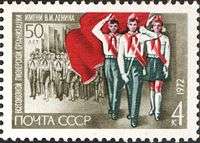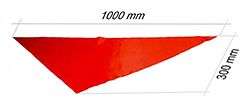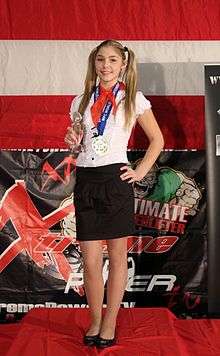Vladimir Lenin All-Union Pioneer Organization
| Vladimir Lenin All-Union Pioneer Organisation Всесоюзная Пионерская организация имени Владимира Ленина | |
|---|---|
 | |
| Founded | 19 May 1922 |
| Dissolved | 1991 |
| Headquarters | Moscow, Russian SFSR, Soviet Union |
| International affiliation | International Committee of Children's and Adolescents' Movements |

The Vladimir Lenin All-Union Pioneer Organization (Russian: Всесою́зная пионе́рская организа́ция и́мени В. И. Ле́нина ![]() listen ; tr.:Vsesoyuznaya pionerskaya organizatsiya imeni V. I. Lenina) was a mass youth organization of the Soviet Union for children of age 10–15 that existed between 1922 and 1991. Similar to the Scouting organisations of the Western world, Pioneers learned skills of social cooperation and attended publicly funded summer camps.
listen ; tr.:Vsesoyuznaya pionerskaya organizatsiya imeni V. I. Lenina) was a mass youth organization of the Soviet Union for children of age 10–15 that existed between 1922 and 1991. Similar to the Scouting organisations of the Western world, Pioneers learned skills of social cooperation and attended publicly funded summer camps.
History


.ogv.jpg)

After the October Revolution of 1917, some Scouts took the Bolsheviks' side, which would later lead to the establishment of ideologically altered Scoutlike organizations, such as ЮК (Юные Коммунисты, or young communists; pronounced as yook) and others.
During the Russian Civil War from 1917 to 1921, most of the Scoutmasters and many Scouts fought in the ranks of the White Army and interventionists against the Red Army.
Those Scouts who did not wish to accept the new Soviet system either left Russia for good (like Oleg Pantyukhov and others) or went underground.
However, clandestine Scouting did not last long. Komsomol persistently fought with the remnants of the Scout movement. Between 1918 and 1920, the second, third, and fourth All-Russian Congresses of the Russian Union of the Communist Youth (Российский коммунистический союз молодёжи, or Rossiyski kommunisticheskiy soyuz molodyozhi) decided to eradicate the Scout movement and create an organization of the communist type, that would take Soviet youth under its umbrella. This organization would properly educate children with Communist teachings.[1]
On behalf of the Soviet Government Nadezhda Krupskaya (Vladimir Lenin's wife and the People's Commissar of State for Education) was one of the main contributors to the cause of the Pioneer movement. In 1922, she wrote an essay called "Russian Union of the Communist Youth and boy-Scoutism." However, it was the remaining scoutmasters themselves who supported the Komonsol and the Red Army, like Innokentiy Zhukov and some others around Nikolaj Fatyanov's "Brothers of the fire", who introduced the name "pioneer" to it and convinced the Komsomol to keep the scout motto "Be prepared!" and adapt it to "Always prepared!" as the organizational motto and slogan.[2]
Just some days before the Komsomol conference the Moscow scoutmasters adopted a "Declaration of the scoutmasters of Moscow concerning the question of the formation of a children's movement in the RSFSR"[3] on May 13, 1922. Thereby they suggested to use the scouting system as a foundation of the new communist organization for children, and give the "Young pioneers" name to it.
The main contribution of the scoutmasters was the introduction of the new expression system scouting into the discourse on communist children's and youth organizations. By doing so they avoided the dissolution of the scout organization as it would happen sooner or later to any organization opposed to the Komsomol.
On May 19, 1922 the second All-Russian Komsomol Conference adopted the scoutmasters' suggestions and decided to "work on the question of a children's movement by using the re-organized system of scouting."[4] During the following years many of the remaining former scoutmasters, who later became the first pioneer leaders in their respective areas, founded pioneer groups and educated future pioneer leaders in these.
May 19, 1922 was later on considered the birthday of the All-Union Pioneer Organization (Всесоюзная пионерская организация, or Vsesoyuznaya pionerskaya organizatsiya). By October 1922 pioneer units nationwide were united to form the Spartak Young Pioneers Organization (SYPO) (Russian: Юные пионеры имени Спартака), which was named after V. I. Lenin by a decision of the Central Committee of Komsomol of January 21, 1924, becoming the Vladimir Lenin Spartak Young Pioneers Organization (VLSYPO). Since March 1926 it bore the name Vladimir Lenin All-Union Pioneer Organization (VLAUPO).
By the middle of 1923 it had 75,000 members. Among other activities, Young Pioneer units, helped by the Komsomol members and leadership at all levels, played a great role in the eradication of illiteracy (Likbez policy) since 1923. Membership was at 161,000 in the beginning of 1924, 2 million in 1926, 13.9 million in 1940, and 25 million in 1974. Many Young Pioneer Palaces were built, which served as community centers for the children, with rooms dedicated to various clubs, such as crafts or sports. Thousands of Young Pioneer camps were set up where children went during summer vacation and winter holidays. All of them were free of charge, sponsored by the government and the Trade Unions.
During the Great Patriotic War the Pioneers worked hard to contribute to the war effort at all costs. Thousands of them died in battles as military personnel and in the resistance against Nazi Germany in its occupied territories as partisans and Pioneers under secrecy in enemy-occupied towns and cities, even in concentration camps. One of them became widely known, for his resistance in Kerch: Volodia Dubinin. Four Pioneers would later receive the coveted Gold Star Medal as Heroes of the Soviet Union, and countless others were awarded various state orders, decorations and medals for acts of bravery and courage in the battlefield, on enemy lines and occupied territories.
Structure
Its main grouping of members until 1942 was the "Young Pioneer detachment," which then typically consisted of children belonging to the same secondary school. From 1942 to October 1990 (when the organization was broken up) the "detachment" was made up of children belonging to the same class within a school, while a school was referred to as a "Young Pioneer group."
There was also an age-scale structure: children of 10–11 years were called Young Pioneers of the first stage; 11–12 years were Young Pioneers of the second stage; 13–15 years were Young Pioneers of the third stage. At age 15, Young Pioneers could join Komsomol, with a recommendation from their Young Pioneer group.
The main governing body was the Central Soviet of the Young Pioneer organization of the Soviet Union, which worked under the leadership of the main governing body of Komsomol.
Its official newspaper was Pionerskaya Pravda.
Main goals and requirements of membership
The main goals and duties of Young Pioneers and requirements of membership were specified by the Regulations of the Young Pioneer organization of the Soviet Union; by the Solemn Promise (given by each Young Pioneer joining the organization); by the Rules of the Young Pioneers; and by the Young Pioneer Motto, всегда готов! (vsegda gotov!, "Always Ready!"). There were two major revisions of them: in 1967 and 1986.
Although membership was theoretically optional, almost all the children in the Soviet Union belonged to the organization; it was a natural part of growing up. Still, joining was not automatic. In the 3rd grade of school, children were allowed to join the Young Pioneer Organization, which was done in batches, as a solemn ceremony, often in a Pioneers Palace. Only the best students were allowed into the first batch, slightly less advanced and well-behaved were allowed into the second batch, several weeks later. The most ill-behaved or low-performing students were given time to 'catch up' and could be allowed to join only in the 4th grade, a year after the first batch of their classmates. Not being admitted at all was odd, and lack of desire to join was considered suspicious.
In line with the Soviet doctrine of state atheism, the «Young Pioneer Leader's Handbook» stated that "every Pioneer would set up an atheist's corner at home with anti-religious pictures, poems, and sayings", in contrast to the traditional Russian Christian icon corners. The Young Pioneers, "as representatives of atheism and political change, encountered massive resistance in rural areas". In the same vein, some students refused to join the organization because of its promotion of Marxist-Leninist atheism.[5]
Symbols, attributes, rituals and traditions


The main symbols of Young Pioneers were the red banner, flag, Young Pioneer's red neck scarf and the organizational badge. Attributes: the bugle, the drum, the organizational uniform (with badges of rank). Some rituals and traditions of the organization were: the Young Pioneer salute, Young Pioneer parade, color guard duty and flag raising. Most common traditions were the Young Pioneers rally (usually round a bonfire, similar to Scout Jamborees) and festivals.
Uniform
The uniform was one of many things that identified Pioneers with each other and the people. The uniform, part of the school uniform worn at school, included the red neckerchief and the organizational and rank badges on the white shirt with long or short pants for boys and long or short skirts for girls, with optional side caps as headdress. Full dress uniforms, used in occasions, were light blue or white with red side caps, the red neckerchief and the badges, with crimson sashes for color bearers and the color escorts. When on outdoor duties brown polo shirts with pants or skirts depending on gender were used, with an optional side cap. Sea service uniforms used sailor caps and blue and white shirts (with Telnyashkas) and pants or skirts depending on the gender, with a brown belt. Instructors and adult leaders wore the same uniforms and the caps in every occasion and in all meetings. In its early years the Pioneers wore campaign hats in major events.
Oath
Solemn promise of a pioneer of the Soviet Union
I (surname, given name), having now joined the ranks of the Vladimir Illich Lenin All-Union Pioneer Organization, in the presence of my comrades solemnly promise: to passionately love my motherland and to cherish it as I can, to live, study, and fight as the Great Lenin has instructed, as the Communist Party teaches me, and as to always carry out the laws of the Pioneers of the Soviet Union.
Songs
Young Pioneer songs were usually sung at various Young Pioneer meetings, in Young Pioneer camps, and at schools. One of the earliest and the most popular song was the Young Pioneer March. It was written in 1922 by Aleksandr Zharov (music by Sergei Dyoshkin) and was sometimes called The Anthem of Young Pioneers. There were a great many other songs, here are some very popular ones:
- Accepting you into Young Pioneers (music by Aleksandra Pakhmutova, lyrics by N.Dobronravov)
- Song about the first Young Pioneer detachment (A.Dolukhanian, S.Runge)
- Our land (Dmitry Kabalevsky, A.Prishelets)
- Gaidar is marching first (Aleksandra Pakhmutova, N.Dobronravov)
- The eaglet (V.Bely, Ya. Shvedov)
- Rise up in bonfires, thee blue nights (S. Kaidan-Deshkin, A. Zharov)
- Warsaw Song (Hostile whirlwinds are blowing above us) - (G. Kryzhanovsky)
- The little joyful drummer (L. Schwarz, Bulat Okudzhava)
- March of Young Pioneer groups (N.Gubar'kov, G. Khodosov)
- May there always be sunshine (A.Ostrovsky, L.Oshanin)
- That's Me and You (Y. Chichkov)
Awards
The Young Pioneers who excelled in academic study, work, sports or social activity were elected to the self-governing institutions, were sent as delegates to the Young Pioneers gatherings (including All-Union ones). The most notable were recognized in the organization's Book of Honor. During World War II, many Young Pioneers fought against Nazis in partisan detachments and/or Party underground units, which existed near their homes on territories occupied by Nazi Germany and their allies, while Pioneers in areas away from enemy lines helped in the homefront efforts. Nearly 30,000 of them were awarded various orders and medals; four Young Pioneers became Heroes of the Soviet Union. One of the famous young pioneer All-Union camps was "Artek" located in Crimea, Ukraine, opened in the 1930s. The camp was located on the top of the mountain "A-yu-dahg" which means "Bear's Mountain". Only the best students were selected to go there based on their grades and leadership. Young communists from other countries were welcome as well.
Present

After the ban of the Communist Party of the Soviet Union in 1991, the organization had to disband. Russia, Ukraine, Moldova, and Belarus are the only Republics where the restored Pioneer Organizations are located and active.
Gallery
- An example of a Pioneers Palace, also known as "palaces of children and youth creativity" in Russia. City of Togliatti
- Young Pioneer camp "Alye Parusa". Monument to Young Pioneer Heroes.
(Russia, Togliatti) - Young Pioneer camp "Alye Parusa". Dining room, in the centre is the monument to USSR founder Vladimir Lenin.
(Russia, city Togliatti) - Young Pioneer camp "Alye Parusa". Coats of arms and flags of the Republics of the Soviet Union.
(Russia, Togliatti) - "Alye Parusa"
See also
- Solemn Promise, Motto and Rules of Young Pioneers
- Young Pioneer camp
- Young Pioneer Palace
- Komsomol
- League of Militant Atheists
- Little Octobrist
- Ernst Thälmann Pioneer Organisation (East German equivalent)
- Young Pioneers of China
References
- ↑ Lewis Stegelbaum and Andrei Sokolov, Stalinism As A Way Of Life, p374 ISBN 0-300-08480-3
- ↑ (German) Sebastian Waack: Lenins Kinder: Zur Genealogie der Pfadfinder und Pioniere in Russland 1908-1924. wvb, Berlin 2008. ISBN 978-3-86573-356-6
- ↑ (Russian) RGASPI Moscow, f.M-1, op.23, d.98, l.29
- ↑ (Russian) VLKSM v rezolucijakh ego s'ezdov i konferencij, p.98
- ↑ Spring, Joel (2012). Pedagogies of Globalization: The Rise of the Educational Security State. Routledge. ISBN 1136502556.
- ↑ Марьяна Наумова вступила в пионеры (in Russian). Beta Press. 2012-05-21. Retrieved 2014-10-24.
External links
| Wikimedia Commons has media related to Pioneers Organization. |
- (Russian) Chronology of the organization
- Schools Hit Books For New Methods, an article about the situation with youth organizations in post-Soviet Russia (archived)
- (Russian) Photos, symbols, songs and personal experience by a former Young Pioneer
- Young Pioneers – This site has information about the Pioneer movement in the Soviet Union as well as in other Communist countries